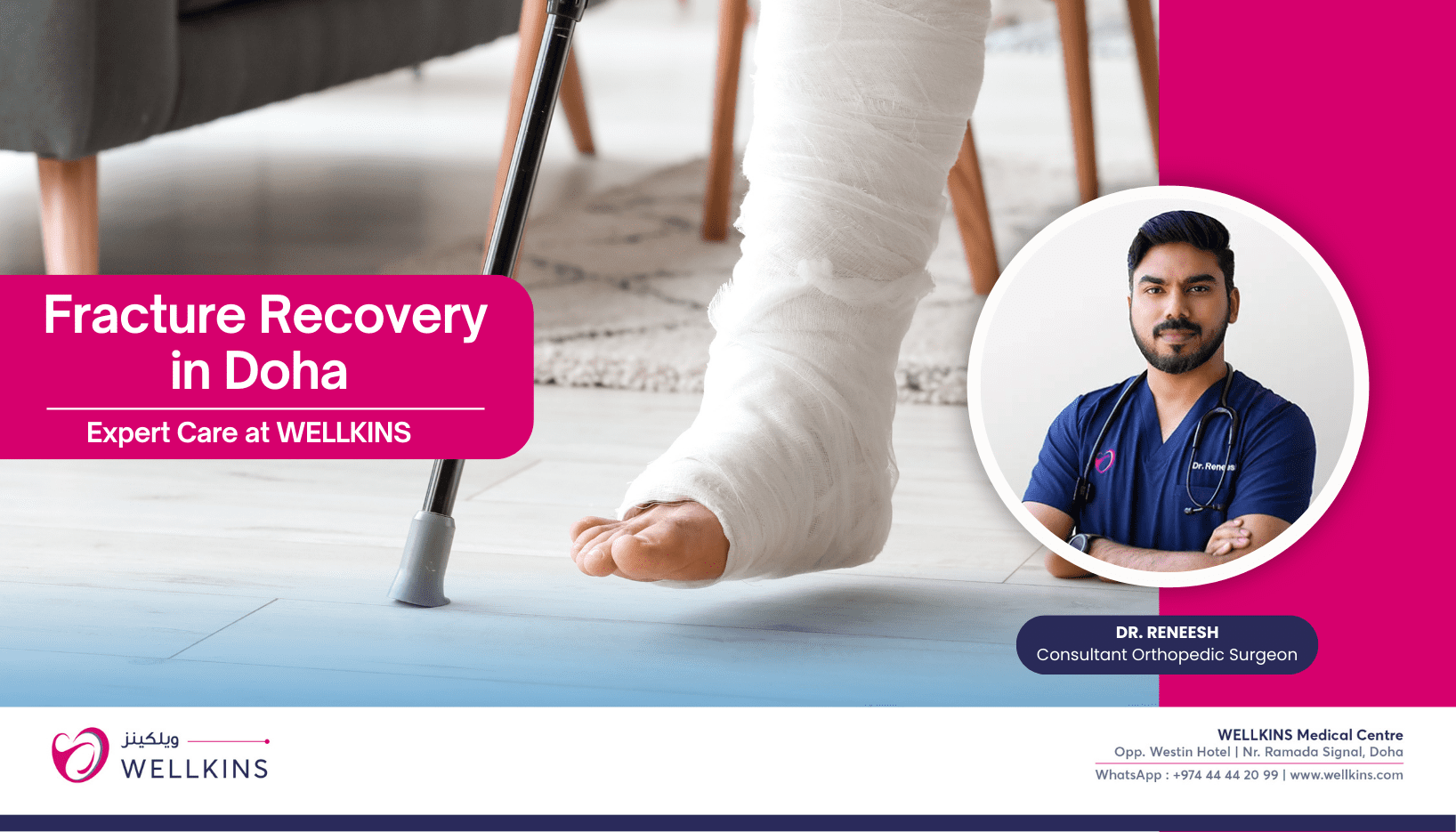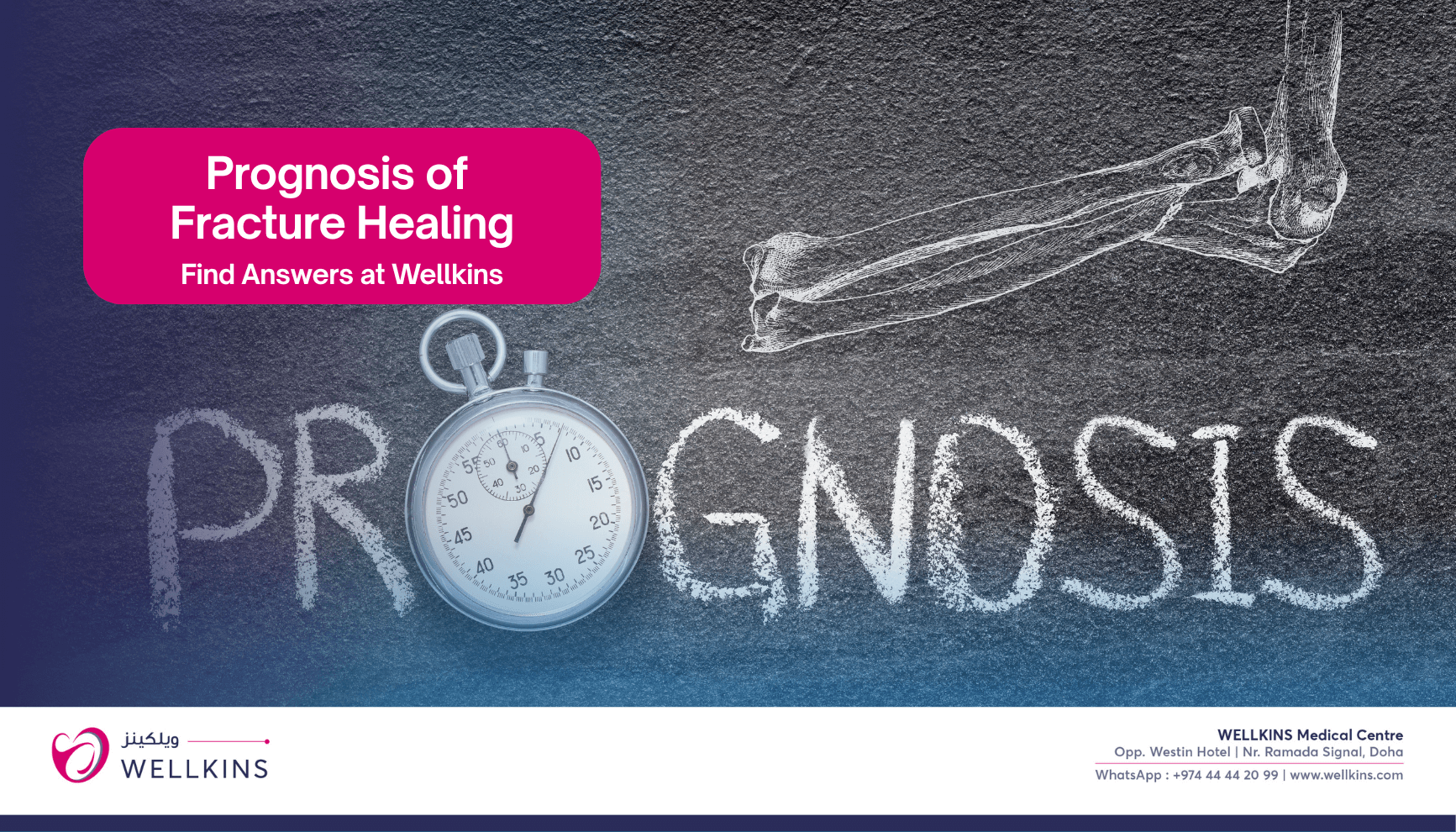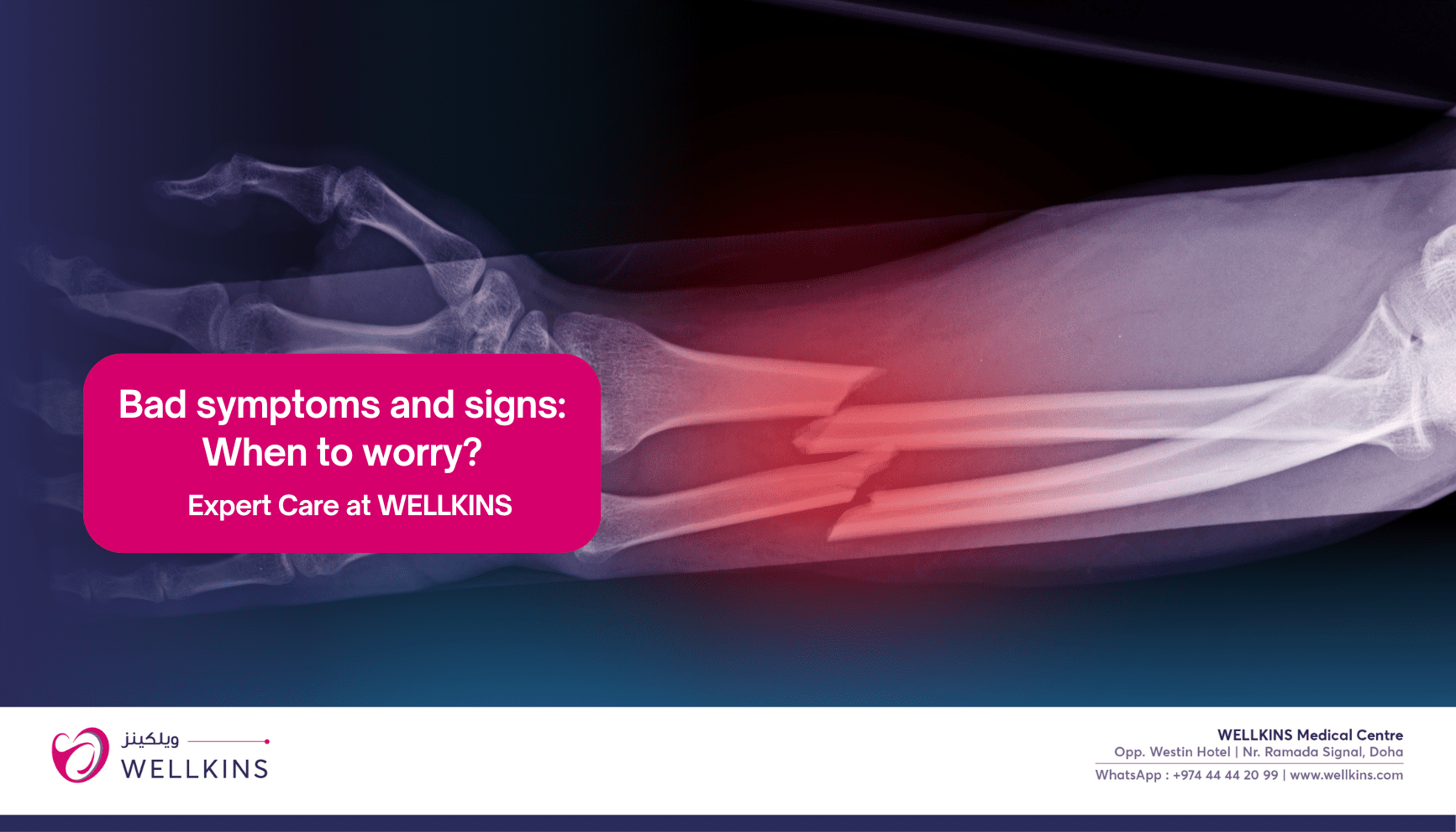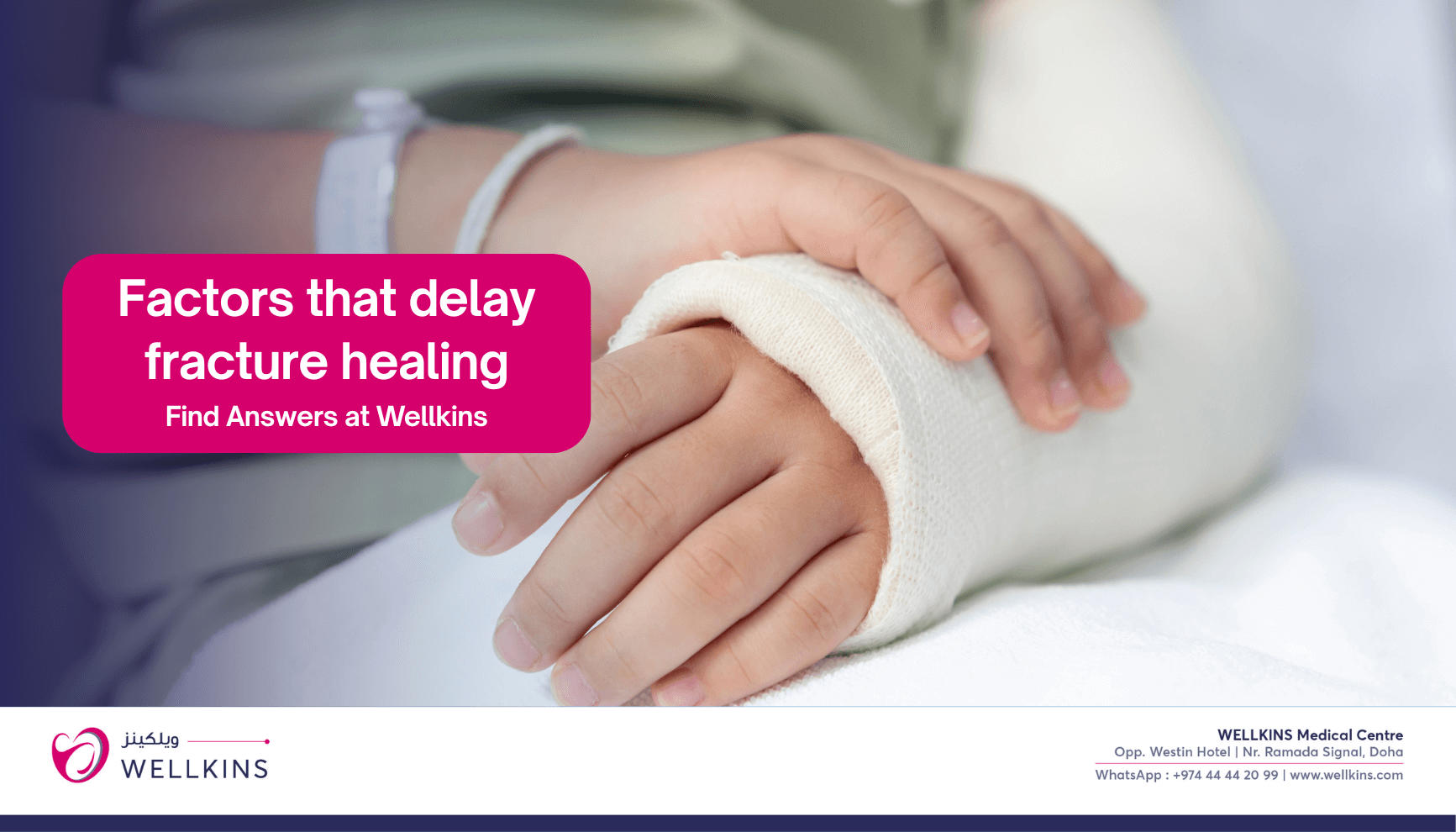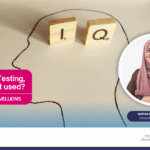Author: Dr.Reneesh (Consultant, Orthopedic Surgeon – WELLKINS Medical Centre)
Fractures, or broken bones, are common injuries that can occur due to trauma, falls, or underlying medical conditions like osteoporosis. As an orthopedic doctor, I often see patients who are anxious about their recovery and want to know what to expect during the healing process. In this blog, I’ll explain the prognosis of fracture healing, the signs that indicate your bone is healing properly, and the warning signs of potential complications.
As an orthopedic surgeon, I frequently manage fractures, which involve breaks in the continuity of a bone. These injuries can range from hairline cracks to complete breaks, often accompanied by displacement of the bone fragments. Fractures are typically caused by acute trauma, such as falls or direct impacts, but can also result from repetitive stress (stress fractures) or weakened bones due to conditions like osteoporosis (pathological fractures).
Prognosis of Fracture Healing
The prognosis for most fractures is excellent, provided that the injury is treated appropriately and the patient follows medical advice. Here’s what you need to know:
1.Healing Time:
Fractures typically take 6–12 weeks to heal, depending on the bone involved and the severity of the break.
Smaller bones (like fingers) may heal in 3–6 weeks, while larger bones (like the femur) can take 3–6 months or longer.
Children heal faster than adults due to their higher metabolic rate and more active bone-forming cells.
2.Factors That Improve Prognosis:
Age: Younger patients heal faster.
Nutrition: A diet rich in calcium, vitamin D, and protein supports bone repair.
Lifestyle: Avoiding smoking and alcohol, which can delay healing.
Proper Treatment: Immobilization (casting, splinting) or surgery, if needed, ensures the bone heals in the correct position.
3.Factors That Delay Healing:
Medical Conditions: Diabetes, osteoporosis, or vascular diseases can slow healing.
Infection: This can disrupt the healing process.
Poor Compliance: Not following your doctor’s instructions (e.g., removing a cast too early) can lead to complications.
Signs of Fracture Healing
As your bone heals, you’ll notice several positive signs that indicate progress. Here’s what to look for:
Reduced Pain:
Pain gradually decreases over time. Initially, the pain may be sharp, but it should become dull and eventually disappear.
Decreased Swelling and Bruising:
Swelling and bruising around the fracture site will subside as healing progresses.
Improved Function:
You’ll regain the ability to move the affected limb or joint without significant pain.
For weight-bearing bones (like the femur or tibia), you’ll gradually be able to put more weight on the limb.
Callus Formation: A hard lump may form at the fracture site as new bone tissue (callus) develops. This is a normal part of the healing process.
X-ray Evidence:
On follow-up X-rays, your doctor will look for signs of healing, such as:
Bridging callus (new bone connecting the broken ends).
Gradual disappearance of the fracture line.
Bad Symptoms and Signs: When to Worry
While most fractures heal without issues, complications can arise. If you experience any of the following symptoms, contact your orthopedic doctor immediately:
Persistent or Worsening Pain:
Pain that doesn’t improve or worsens over time may indicate nonunion (failure to heal) or malunion (healing in the wrong position).
Swelling, Redness, or Warmth:
These could be signs of an infection, especially if accompanied by fever or pus.
Inability to Bear Weight or Use the Limb:
If you’re unable to use the limb after the expected healing time, it may suggest delayed healing or nonunion.
Deformity or Misalignment:
Visible deformity or abnormal alignment of the bone may indicate malunion.
Numbness, Tingling, or Weakness:
These symptoms may suggest nerve damage or compression.
Signs of Infection:
Fever, chills, or foul-smelling discharge from the wound.
Increasing redness, warmth, or swelling at the fracture site.
Compartment Syndrome:
Severe pain, swelling, and tightness in the affected limb.
Numbness, tingling, or pale skin.
This is a medical emergency requiring immediate treatment.
Delayed Healing or Nonunion:
No signs of healing on X-rays after the expected time frame.
PersisFractures, or broken bones, are common injuries that can occur due to trauma, falls, or underlying medical conditions like osteoporosis. As an orthopedic doctor, I often see patients who are anxious about their recovery and want to know what to expect during the healing process. In this blog, I’ll explain the prognosis of fracture healing, the signs that indicate your bone is healing properly, and the warning signs of potential complications.
Tips for Promoting Fracture Healing
As an orthopedic doctor, I always emphasize the importance of patient involvement in the healing process. Here are some tips to help your fracture heal faster and more effectively:
Follow Your Doctor’s Instructions:
Use casts, braces, or crutches as directed.Avoid putting weight on the affected limb until your doctor gives the go-ahead.
Eat a Bone-Healthy Diet:
Focus on foods rich in calcium (dairy, leafy greens) and vitamin D (sunlight, fatty fish).
Include protein sources (eggs, lean meat, beans) to support tissue repair.
Avoid Smoking and Alcohol:
Both can significantly delay bone healing.
Attend Follow-Up Appointments:
Regular check-ups and X-rays are essential to monitor progress and catch complications early.
Physical Therapy:
Once your doctor approves, physical therapy can help restore strength, flexibility, and function.
When to Seek Medical Attention
If you notice any of the following, contact your orthopedic doctor immediately:
☑️Severe or worsening pain.
☑️Signs of infection (fever, redness, swelling).
☑️Numbness, tingling, or weakness.
☑️Inability to move the limb or bear weight.
Fracture healing is a natural process, but it requires patience, proper care, and close monitoring. As an orthopedic doctor, my goal is to ensure your bone heals correctly and that you regain full function of the affected limb. By following medical advice, maintaining a healthy lifestyle, and watching for warning signs, you can optimize your recovery and avoid complications.
If you have any concerns about your fracture or healing progress, don’t hesitate to reach out to your healthcare provider. Early intervention can make all the difference in your recovery journey.
Read more about the orthopedic services at wellkins here: https://wellkins.com/orthopedics/


